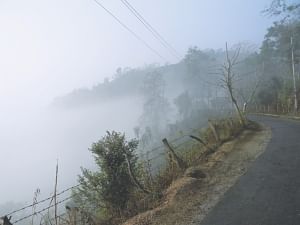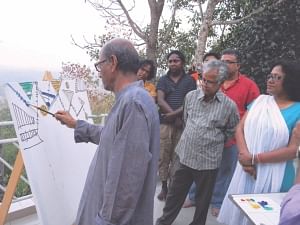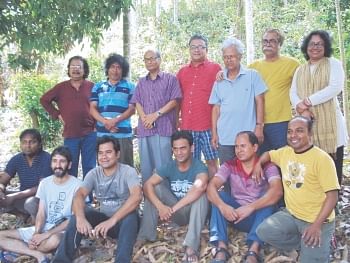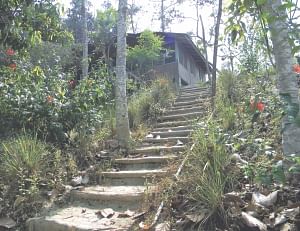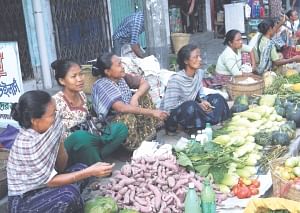| Home - Back Issues - The Team - Contact Us |
 |
| Volume 11 |Issue| 15 | April 13, 2012 | |
|
|
Reflections Look, Feel, Paint! Camping with artists at Bandarban Sharier Khan
When our large bus entered the hilly Bandarban town on March 23, the driver told us, “Sir, this is where you get down. We can't go further on this bus.” The organiser of this trip artist Goutam Chakraborty, whom I call as Goutamda, shook his head. “We have rented this bus so that we can go together with all our art material to Milonchhari. Let's go,” Goutamda said. My Ittefaq colleague Asif confused the driver further, “I just went there on a bus like this last month. There is no problem.” The driver was still hesitant as the local bus operators were telling him not to go. But with 12 artists in the bus eagerly waiting to reach Milonchhari Hill Resort, the driver finally surrendered to Goutamda's persuasion and started for the journey uphill through the narrow road. On the way, we ignored one more warning from local bus operators till we came- face to face- with a very narrow steel bridge. The driver stopped and said, “No sir. I can't cross that. My bus won't enter this bridge.”
We negotiated for a minute till we got down from the bus. Indeed, the bus was too big for the road and the bridge. “Ah, okay… we have to find an alternative,” said Goutamda. "We are just a couple of kilometres off from Milonchhari". The bus was blocking the road and there was no space to turn the bus. The driver precariously drove the bus in reverse gear, with people on the road guiding him to avoid falling off the edge. It took him 15 minutes to drive back 200 metres where there was a local bus stop with some space to turn the bus around. We hired a rickety minibus, moved our belongings and squeezed ourselves into what seemed to be the most uncomfortable seats in the world. The midday sun was now at its cruelest; the minibus had no AC in it. Thankfully we reached the Milonchhari hill resort in no time. *** Bandarban has a landscape that would inspire any artist. However, during March and April, many trees lose their leaves, the grass dries up and the hills look barren. There are patches of green here and there, but many places wear a dusty look from a distance. Nevertheless it still offers a lot of green and landscape. Plus you can see the Sangu river from the hill resort. What a great view! These are the reasons why Goutamda picked this venue for the five-day art camp where the dozen artists would work on acrylic on canvas and water colour on paper. The artists went up to their cottages to freshen up. They were: Samarjit Roy Chowdhury, Hamiduzzaman Khan, Tarun Ghosh, Kazi Rakib, Masuda Kazi, Shamiran Chowdhury, Ashraful Hasan, Biswajit Goswami, Kamaluddin, Shohag Parvez, Nagarbashi Barman, and Tarikat Islam. Of them Samarjit Roy Chowdhury had taught all the other artists. His student Hamiduzzaman Khan was the other artist who had also taught some of them. We regrouped at the reception cum dining hall for lunch. Soon after gobbling up the lunch like there was no tomorrow, we were joined by the resort's chief Khokon Bhai. Khokon Bhai was introduced to artist Rakib Bhai. They looked great face to face; both of them had very thick moustaches that hid their mouths. When they talked, I just saw a pair of mustaches mimicking lip movements. It was a war of the mustaches. In the evening, the artists gathered at the terrace of the reception overlooking the Sangu river and the magical hills of Bandarban under evening sunlight to launch the five-day art camp. Samarjit Roy Chowdhury inaugurated the camp by drawing on a canvas. Eleven other artists and Goutamda also put their strokes and signatures on the same canvas. *** One striking thing about Milonchhari is the omnipresence of geckos (takkhak). We got on a bungalow perched on a slope. I was staying in a three-bed room sharing with Goutamda and Asif. As soon as we got in the room, we realised there was a takkhak living on the ceiling. Regardless, we went to sleep at around 10.30 pm. I woke up suddenly at 5 am, upon hearing a roaring sound. I sprang up and saw Goutamda sitting on his bed with a sleepy yet harassed face. “What's up?” I asked him. Without an answer he went back to sleep. I got his answer at breakfast. Goutamda smiled while munching on his parota, “I dreamt that I was sleeping somewhere. My hand landed on something soft. I opened my eyes and I saw this lizard sitting right there on my bed. So I threw it away screaming.” *** I caught up with Biswajit in the dining hall terrace. He looked perplexed with two near-finished paintings on canvas before him. “What's wrong?” I asked. “Well, damn this,” he showed me a bottle of turpentine or 'turpin oil'. Ashraf who was painting nearby explained, “well its written turpin oil on the bottle. But it's actually a thinner. You can smell thinner there.” Biswajit shook his head, “all the time I was using this oil wondering why was the oil drying up so fast! I did not realise it was actually thinner.” ***
The five days passed in a flash. Goutamda arranged two microbuses to drive back to Chittagong from where we would return on train on March 27. After a delay of 90 minutes we finally boarded the train. Now it was the artists' turn to tell me some of their stories of this art camp. Tarikat Islam started: “I went to the Mog Bazar (the market of the Mog people) with others on the third day. Three of us had planned to buy this bamboo basket used by the indigenous people. After a 40-minutes search, just when we were giving up, we suddenly found this lady with exactly three such baskets. And her price was reasonable. What a coincidence!” Tarun Ghosh shared his memory: “We went to the Sharna Mandir (Bandarban's golden temple) on a Chader Gari (a modified four-wheeler) yesterday. Before we started, we hung two bunches of small hilly bananas from the car's frame. We got up and the car started. Now guess how long it took to finish the two bunches of bananas? Just two minutes!” For Shamiran Chowdhury, it was the second art camp in Milonchhari. “Usually wherever I go, I paint women. But this time, there was no woman subject in my painting as I did not come across a girl who represents Bandarban,” he said. Nagarbashi Barman noted, “I intended to paint on the theme of Krishnachura seeds. But as soon as I started drawing, I found out that others also had the same idea. My idea was a total flop!” Nagarbashi visited a village named Hatibhanga. “There are 37 indigenous families there. I met a boy who is in class eight. He told me he wanted to become a lawyer,” Nagarbashi smiles saying that modern ambitions have reached even the indigenous communities.
Seniormost artist Samarjit Roy Chowdhury pointed out, “I found out at the camp that one of the boys—Shohag-- sings quite well. I also noted that all the young people are very serious about their work. When we were coming back and waiting at the station, the boys started doing sketches.” Hamiduzzaman who had visited the spot many times before, encouraged others to visit the Mog Bazaar to get inspired by the indigenous culture: “If we had not been there, it would have indeed been a pity. They were selling curd inside bamboo pieces. They were selling monitors' meat; unknown vegetables; yellow and golden frogs. You will find these subjects in our paintings. They also pack everything very artistically. The market is quite big—it stretches some two kilometres.” Biswajit added : “They are selling tamarind by wrapping them in banana leaves at Mog Bazaar. I took a drawing board and papers, and my camera. I forgot to draw and I was busy taking pictures. I put my board in a shop and I went out there to buy a special knife. When we came back to Milonchhari, I discovered that I left my drawing board. Well that's my gift to the local people.” Ashraf said he usually worked on natural disaster as a subject. “Here I came close to the nature which was very rough. But even in this roughness, I found a greatness —which I tried to portray in my work here.” Kazi Rakib noted, “Yesterday was the last day of the camp. Goutam asked us to submit our works by 4 pm. So we were all rushing. While we were trying to meet the deadline, I heard Tarun's voice from the Resort's kitchen. He was cooking green jackfruit! I complained to Goutam that Tarun was not working but Goutam ignored me; he loves food. Well Tarun is a great cook—so we really enjoyed the jackfruit during lunch.” “Every night we had parties in different cottages. A day before Sohag was singing and our sirs (teachers) joined in. And soon, Hamid sir was busy trying to break the floor down in his attempt to dance,” laughed Rakib. For Rakib's wife Masuda Kazi, it was her first trip to Bandarban. “Before coming here, some friend of mine asked me to mind my shoes as there are leeches around and they get inside the shoes. So upon coming here, I never left my shoes outside of the room. Our cottage is a bit isolated overlooking the hills. That morning when I woke up and opened the door, there was mist all around our room. And as far as my eyes went outside, I saw this sea of cloud through which I could see silhouettes of hill tops. I felt like I was standing on a cottage in the sea.” Sohag a regular visitor of Bandarban said: “I have worked on travel for eight years. I have painted the environment of Murong, Marma, Tripura, Chakma, Khasia and other indigenous people for eight years. It is always a pleasure to return here, that too, to participate in an art camp. It also gives me pleasure to entertain others with my songs. We sang, we danced and also talked about art.” Kamal shared his memory: “Compared to flat lands, hills always give you a three dimensional effect on canvas which I enjoy to work on. I like green as an optically appealing colour; but I avoid using green directly because it feels crude. I always used green in textures. As the surroundings were arid this season, I could use green as part of the textures.” *** With 29 acrylic and 26 water colour works generated at the Art Camp, Goutam plans to organise the exhibition at Galleri Kaya at Sector 4 of Uttara next year. The writer is Deputy Editor (Reporting), The Daily Star.
|
